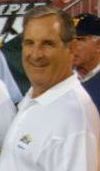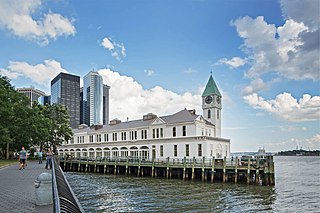
John Burgee is an American architect noted for his contributions to Postmodern architecture. He was a partner of Philip Johnson from 1967 to 1991, creating together the partnership firm Johnson/Burgee Architects. Their landmark collaborations included Pennzoil Place in Houston and the AT&T World Headquarters in New York. Burgee eased Johnson out of the firm in 1991, and when it subsequently went bankrupt, Burgee's design career was essentially over. Burgee is retired, and resides in California.

Billie Jean King is an American former world No. 1 tennis player. King won 39 Grand Slam titles: 12 in singles, 16 in women's doubles, and 11 in mixed doubles. King was a member of the victorious United States team in seven Federation Cups and nine Wightman Cups. For three years, she was the U.S. captain in the Federation Cup.

The Heisman Memorial Trophy is awarded annually to the most outstanding player in college football. Winners epitomize great ability combined with diligence, perseverance, and hard work. It is presented by the Heisman Trophy Trust in early December before the postseason bowl games.

Jacob Ruppert Jr. was an American brewer, businessman, National Guard colonel and politician who served for four terms representing New York in the United States House of Representatives from 1899 to 1907. He also owned the New York Yankees of Major League Baseball from 1915 until his death in 1939.

Duncan "Dick" Ebersol is an American television executive and a senior adviser for NBC Universal Sports & Olympics. He had previously been the chairman of NBC Sports, producing large-scale television events such as the Olympic Games and National Football League broadcasts.

Joseph Michael Bellino was an American football halfback who won the Heisman Trophy in 1960 playing for the United States Naval Academy and played in the American Football League (AFL) for the Boston Patriots. He was inducted into the College Football Hall of Fame in 1977.

Joseph Robert Theismann is an American former professional football player, sports commentator, corporate speaker and restaurateur. He rose to fame playing quarterback in the National Football League (NFL) and Canadian Football League (CFL). Theismann spent 12 seasons with the Washington Redskins, where he was a two-time Pro Bowler and helped the team to consecutive Super Bowl appearances, winning Super Bowl XVII over the Miami Dolphins and losing Super Bowl XVIII. He played college football for the Notre Dame Fighting Irish and was inducted into the College Football Hall of Fame in 2003.

Anthony Christopher Kubek is an American former professional baseball player and television broadcaster. During his nine-year playing career with the New York Yankees, Kubek played in six World Series in the late 1950s and early 1960s, starting in 37 World Series games. For NBC television, he later broadcast twelve World Series between 1968 and 1982, and fourteen League Championship Series between 1969 and 1989. Kubek received the Ford C. Frick Award in 2009.

Fred Wilpon is an American real estate developer and former baseball executive. He was principal owner of the New York Mets from 1987 to 2020.

Terry Wayne Baker is an American former professional football player who was a quarterback in the National Football League (NFL) and Canadian Football League (CFL). He played college football and basketball at Oregon State University in Corvallis, where he was a member of Phi Delta Theta. Baker played for the Oregon State Beavers football team from 1960 to 1962, winning the Heisman Trophy as senior. In the spring of his senior year, he led their basketball team to the Final Four of the NCAA tournament. To date, he is the only athlete to win a Heisman Trophy and play in the Final Four. Baker was the first overall pick in the 1963 NFL draft and played with the Los Angeles Rams from 1963 to 1965. He then played for one season in the CFL with the Edmonton Eskimos in 1967. Baker was inducted into the College Football Hall of Fame in 1982.

The New York Yankees are an American professional baseball team based in the New York City borough of the Bronx. The Yankees compete in Major League Baseball (MLB) as a member club of the American League (AL) East division. They are one of two major league clubs based in New York City alongside the National League (NL)'s New York Mets. The team was founded in 1903 when Frank Farrell and Bill Devery purchased the franchise rights to the defunct Baltimore Orioles after it ceased operations and used them to establish the New York Highlanders. The Highlanders were officially renamed the New York Yankees in 1913.
Tod Williams Billie Tsien Architects are a husband-and-wife architectural firm founded in 1986, based in New York. Williams and Tsien began working together in 1977. Their studio focuses on work for institutions including museums, schools, and nonprofit organizations.

Martin E. Appel, is an American public relations and sports management executive, television executive producer, baseball historian and author.
The 1949 Notre Dame Fighting Irish football team represented the University of Notre Dame during the 1949 college football season. The Irish, coached by Frank Leahy, ended the season with 10 wins and no losses, winning the national championship. The 1949 team became the seventh Irish team to win the national title and the third in four years. Led by Heisman winner Leon Hart, the Irish outscored their opponents 360–86. The 1949 team is the last team in what is considered to be the Notre Dame Football dynasty, a stretch of games in which Notre Dame went 46–0–2 and won three national championships and two Heisman Trophies. The Irish squad was cited by Sports Illustrated as the part of the second-best sports dynasty of the 20th century and second greatest college football dynasty.

The New York Landmarks Conservancy is a non-profit organization "dedicated to preserving, revitalizing, and reusing" historic structures in New York state. It provides technical and financial skills to owners of historic properties. Since its founding, the conservancy has provided more than $60 million in grants and loans.
This is a list of female sports athletes who have been inducted into the International Women's Sports Hall of Fame, which recognizes the athletic and coaching achievements of women. Selections are made worldwide and are based on achievements, breakthroughs, innovative style and ongoing commitment to the development of women’s sports. Sports organizations, sports historians and the public may nominate potential candidates and The Hall of Fame Selection Committee votes to select inductees. Since its inception in 1980 under the auspices of the Women's Sports Foundation, a total of 113 athletes and 21 coaches have been inducted. The United States is represented by 94 (70%) of the 134 inductees.
Diane Straus was an American magazine publisher and platform tennis player. She was the publisher of The American Prospect and Washington Monthly. She was an inductee of the Platform Tennis Hall of Fame.














